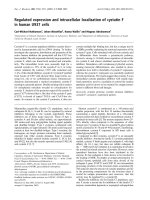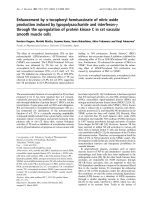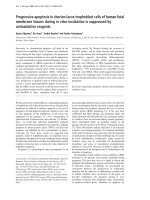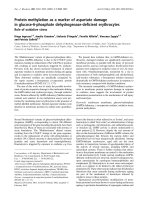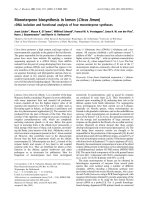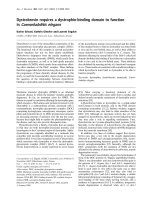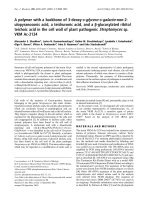Báo cáo y học: "Regional differences in prediction models of lung function in Germany" ppsx
Bạn đang xem bản rút gọn của tài liệu. Xem và tải ngay bản đầy đủ của tài liệu tại đây (1.26 MB, 11 trang )
Schnabel et al. Respiratory Research 2010, 11:40
/>Open Access
RESEARCH
BioMed Central
© 2010 Schnabel et al; licensee BioMed Central Ltd. This is an Open Access article distributed under the terms of the Creative Commons
Attribution License ( which permits unrestricted use, distribution, and reproduction in
any medium, provided the original work is properly cited.
Research
Regional differences in prediction models of lung
function in Germany
Eva Schnabel*
1,2
, Chih-Mei Chen
1,2
, Beate Koch
3
, Stefan Karrasch
4,5
, Rudolf A Jörres
5
, Torsten Schäfer
1
,
Claus Vogelmeier
6
, Ralf Ewert
3
, Christoph Schäper
3
, Henry Völzke
3,7
, Anne Obst
3
, Stephan B Felix
3
, H-
Erich Wichmann
1,8
, Sven Gläser
3
, Joachim Heinrich
1
for the KORA (Cooperative Research in the Region of Augsburg)
study group
Abstract
Background: Little is known about the influencing potential of specific characteristics on lung function in different
populations. The aim of this analysis was to determine whether lung function determinants differ between
subpopulations within Germany and whether prediction equations developed for one subpopulation are also
adequate for another subpopulation.
Methods: Within three studies (KORA C, SHIP-I, ECRHS-I) in different areas of Germany 4059 adults performed lung
function tests. The available data consisted of forced expiratory volume in one second, forced vital capacity and peak
expiratory flow rate. For each study multivariate regression models were developed to predict lung function and Bland-
Altman plots were established to evaluate the agreement between predicted and measured values.
Results: The final regression equations for FEV
1
and FVC showed adjusted r-square values between 0.65 and 0.75, and
for PEF they were between 0.46 and 0.61. In all studies gender, age, height and pack-years were significant
determinants, each with a similar effect size. Regarding other predictors there were some, although not statistically
significant, differences between the studies. Bland-Altman plots indicated that the regression models for each
individual study adequately predict medium (i.e. normal) but not extremely high or low lung function values in the
whole study population.
Conclusions: Simple models with gender, age and height explain a substantial part of lung function variance whereas
further determinants add less than 5% to the total explained r-squared, at least for FEV1 and FVC. Thus, for different
adult subpopulations of Germany one simple model for each lung function measures is still sufficient.
Background
Spirometric lung function measurements are used for the
diagnosis, assessment and management of heart and lung
diseases. Furthermore, lung volumes contain prognostic
potencies in general populations [1]. In clinical applica-
tions, forced expiratory volume in one second (FEV
1
) and
forced vital capacity (FVC) are usually expressed as per-
cent-predicted values. To diagnose patients with chronic
obstructive lung disease (COPD) or asthma, the Global
Initiative for Chronic Obstructive Lung Disease (GOLD)
and the Global Initiative for Asthma (GINA) established
categories according to FEV
1
percent-predicted values
and the ratios of FEV
1
/FVC [2,3]. In research, FEV
1
values
are also used to normalize the data for known anthropo-
metric determinants [4,5].
Predicted values are commonly derived from measure-
ments performed in a reference population of healthy
subjects, stratified according to gender, age and height.
To obtain reliable reference values of lung function it is
crucial that the reference group is representative and, in
particular, free of conditions interfering with the results.
Despite these efforts, lung function has a wide variation
even in healthy subjects, suggesting that the commonly
used determinants do not sufficiently describe the lung
function or that the reference populations used differ
considerably. In addition to a surprisingly large residual
* Correspondence:
1
Helmholtz Zentrum München, Center for Environmental Health, Institute of
Epidemiology, Neuherberg, Germany
Full list of author information is available at the end of the article
Schnabel et al. Respiratory Research 2010, 11:40
/>Page 2 of 11
variation, this variation is reflected in differences
between currently used reference equations for lung
function and discrepancies in international criteria for
identifying COPD cases [6-11].
It is well known that in addition to gender, age and
height, there are several other factors influencing lung
function. The American Thoracic Society (ATS) summa-
rized these sources of variation [12]. Apart from technical
factors related to equipment and procedures, biological
and environmental factors are among the other possible
sources. These include racial and ethnic background;
anthropometric and genetic factors; occupational and
environmental exposures; nutrition; childhood infec-
tions; cardiovascular, metabolic and hormonal disorders;
and other factors that have not yet been defined.
In addition, there may be differences in lung function
between subpopulations, which should be considered
when establishing prediction equations. For example,
varying anthropometric characteristics, environmental
exposures or social conditions between distinct parts of a
country might lead to different reference values.
As a result, the aim of this study was to analyse whether
lung function determinants differ between subpopula-
tions within Germany. The comparison of the three stud-
ies performed in Germany offers the unique opportunity
to analyse whether prediction equations developed for
one subpopulation adequately describe lung function for
another subpopulation within a country and whether the
major determinants of lung function show similar effect
size.
Methods
Study population
We report the results of three studies which were per-
formed in northern, central and southern areas of Ger-
many. Within the study populations there are no essential
differences concerning ethnic background. The majority
of participants are Germans (more than 93%).
SHIP-I
Within the cross-sectional study SHIP-0 (Study of Health
in Pomerania), 4310 individuals, aged 20-79 years, were
recruited in the region of Western Pomerania in the
Northern part of Germany. Data was collected during
1997 and 2001. Study details are given elsewhere [13].
The 5-year-follow-up SHIP-I, with 3300 participants, was
conducted between March 2003 and July 2006. Within
the framework of the SHIP-I study lung function tests
were performed in 1809 subjects of age 20-85 years.
Additional information was evaluated by medical exami-
nation and questionnaires.
ECRHS-I Erfurt
The cross-sectional study ECRHS-I Erfurt (European
Community Respiratory Health Survey) was performed
from 1990 to 1992 in Erfurt, Germany; its design has
been described in detail [14,15]. In a two-step approach
6291 randomly chosen individuals were asked to reply to
a short questionnaire on respiratory symptoms (stage I).
Afterwards a population-based random sample of the
4332 stage I responders was invited to attend a clinical
examination, perform lung function measurement and
answer a detailed questionnaire (stage II). The age range
covered subjects between 20 and 65 years. In stage II,
1282 subjects underwent the clinical examination and
answered the detailed questionnaire, and 1162 lung func-
tion tests were available.
KORA C
The community-based study KORA C (Cooperative
Research in the Region of Augsburg) is based on the third
MONICA survey, which was performed in Augsburg,
Germany between 1994 and 1995. The objective and pro-
tocol of the MONICA surveys in Augsburg have been
published [16]. The third MONICA survey comprised a
random sample of 4178 individuals stratified for age and
sex, which was drawn from all registered residents of the
city of Augsburg aged 25-74 years. KORA C is a subset of
the third MONICA survey enriched with subjects with
positive testing for specific IgE against common aeroal-
lergens (grass and birch pollen, house-dust mite, cat, and
Cladosporium herbarum). The KORA C study was per-
formed between September 1997 and December 1998.
Details of the KORA C design have been reported [17].
Finally, 1537 subjects participated (60.5%), of whom
50.2% had at least one positive radioallergosorbent test
(RAST) result. Besides questionnaire evaluations and
medical examinations, lung function tests were per-
formed in 1088 participants who were younger than 60
years.
Outcome assessment
Lung function
All lung function tests were conducted based on the
ECRHS protocol [15]. Forced vital capacity (FVC), forced
expiratory volume in one second (FEV
1
) and peak expira-
tory flow rate (PEF) were determined by spirometry in all
subjects who did not smoke or use inhalers 1 hour prior
to the test. All measured lung function parameters are
pre-bronchodilation values. Tests were assumed as valid
if at least two technically satisfactory maneuvers were
obtained within a maximum of 9 trials. The final values of
FVC and FEV
1
were determined based on the best
maneuver as defined by the highest sum of FVC and
FEV
1
.
Determinants
Anthropometric measurements, computer-assisted stan-
dardized interviews and questionnaires were performed
in all three studies. The following determinants were
taken into account for developing regression models to
predict lung function: gender, age, height, weight, obesity,
Schnabel et al. Respiratory Research 2010, 11:40
/>Page 3 of 11
education level, packyears of cigarette smoking for all for-
mer and current smokers, environmental tobacco smoke,
medication, doctor-diagnosed atopic diseases (asthma),
cardiovascular diseases (hypertension, heart attack,
stroke) and diabetes. Height and weight were measured
and obesity was defined as having a BMI ≥ 30 (body mass
index). Education level was defined by the highest gradu-
ation: low (less than O-level), medium (O-level) and high
(more than O-level). The smoking status (never, current,
or former-smoker) and environmental tobacco smoke at
home or at work was assessed by self-report. Former-
smokers were all people who do not currently smoke but
have in the past. The medication was recorded by a com-
puter-aided method using the ATC code. A number of
drugs influencing lung function (e.g. sympathomimetic,
glucocorticoid, anticholinergic and antiallergenic drugs)
were considered for the analysis. Doctor-diagnosed
atopic, cardiovascular diseases and diabetes were based
on self-report. A positive atopy status was defined as at
least one doctor-diagnosed atopic disease.
Statistical analyses
Descriptive statistical analysis for the study populations
and lung function measures was done using SAS, version
9.13, and data was expressed using frequencies, percent-
ages or mean and standard deviation (SD). Chi-square
tests and Kruskal-Wallis tests were employed to analyse
differences between studies. For each study, multivariate
regression models were developed to predict lung func-
tion. All predictors were initially entered into the model
and the final regression equations were chosen based on
the adjusted r-squared value after retaining only the sta-
tistically significant predictors. An intracluster correla-
tion of a hierarchical model was used to assess the
heterogeneity between the studies. Additionally, Bland-
Altman plots were used to evaluate the degree of agree-
ment between the predicted values of the different
regression models and the actually measured values.
Results
For the ECRHS-I Erfurt study lung function test results
from 1162 subjects were analysed, for KORA C results
from 1088 subjects, and for SHIP-1 results from 1809
subjects (Table 1). There were no major differences
between these populations in terms of gender and height.
However, the SHIP population had significantly higher
values for age (mean ± SD: 52.5 ± 13.7), weight (80.3 ±
15.9) and BMI (27.8 ± 4.7), and it had more than twice as
high of an obesity rate (29.1%) in comparison to the two
other populations (p < 0.01 for each comparison). The
percentage of hypertension and diabetes was highest in
the SHIP study, while asthma was more prevalent in the
KORA study, which might be due to the study design of
KORA C.
Analysis of FEV
1
Regarding lung function, the SHIP population showed
lower FEV
1
(mean ± SD: 3.5 ± 0.8; p < 0.01 each), FVC
(mean ± SD: 3.9 ± 1.0; p < 0.01 each) and PEF values
(mean ± SD: 7.3 ± 2.1; p < 0.01 each) compared to the
ECRHS and KORA populations (Table 2). However, these
differences disappeared when we restricted our analysis
to the same age range in all three studies.
The final regression equations for FEV
1
showed
adjusted r-squared values between 0.65 and 0.73 (Addi-
tional File 1: Table S1). In all three studies, gender, age,
height, packyears of cigarette smoking and asthma were
significant determinants of FEV
1
, with similar effect sizes
in each study. Lower FEV
1
was associated with female
gender, higher age, packyears, and asthma; FEV
1
increased with height. The negative association with
asthma was most pronounced in the ECRHS and SHIP
study. Additionally, a low level of education corresponded
to lower FEV
1
in these two studies. Nevertheless, there
were differences between the three studies in terms of the
other determinants. In KORA environmental tobacco
smoke (ETS) and the use of at least one drug influencing
lung function was associated with lower FEV
1
, while in
the SHIP study obesity was found to have a negative
effect on FEV
1
.
Analysis of FVC
For FVC, adjusted r-squared values ranged between 0.69
and 0.75. Here again gender, age, height and packyears
were significant determinants in all three studies (Addi-
tional File 1: Table S1). In addition, a low education level
was negatively associated with FVC in ECRHS and
KORA. This was also the trend in ECRHS and SHIP for
subjects with asthma. Obesity and diabetes were linked
with low FVC in the SHIP study, while this was true for
ETS and the use of medication influencing lung function
in the KORA study. However, the effect of diabetes in the
SHIP study disappeared when the analysis was restricted
to the same age group as in the other studies.
Analysis of PEF and FEV
1
/FVC
The adjusted r-squared values for PEF ranged between
0.46 and 0.61 (Additional File 1: Table S1). In all three
regression models gender, age, height, packyears and
education level were significant but the effects of the
other determinants varied between the studies. Hyper-
tension was associated with low PEF in the ECRHS study,
medication in KORA, and asthma in SHIP. Moreover,
PEF slightly increased with weight in the SHIP study.
Regarding the ratio FEV
1
/FVC, adjusted r-squared val-
ues ranged between 0.10 and 0.17 (Additional File 1:
Table S1). Only gender and height were significant pre-
dictors in all studies; age showed an effect only in the
Schnabel et al. Respiratory Research 2010, 11:40
/>Page 4 of 11
ECRHS study. Additionally, weight, asthma, packyears
and medication showed very small effects.
Further analyses
Smoother plots were used to check whether height and
weight were linearly associated with lung function. After-
wards a cubic regression model was developed, that con-
firmed the linear relationship between lung function
measures and height and weight. Thus, we did not
include higher order terms of height and weight in our
analysis.
Furthermore, we compared the model predictivity of
our regression models, developed in the current analysis,
with standard models that only include gender, age and
height as predictors. For all three lung function parame-
ters our models obtained slightly higher adjusted r-
Table 1: Characteristics of the study populations ECRHS-I, KORA C and SHIP-I
ECRHS-I (N = 1162) KORA C (N = 1088) SHIP-1 (N = 1809)
n/N (%) n/N (%) n/N (%)
Sex (Male) 601/1162 (51.7) 520/1088 (47.8) 885/1809 (48.9)
Age (y)* 41.9 ± 12.3 44.7 ± 9.2 52.5 ± 13.7
Height (cm) 169.8 ± 9.0 170.4 ± 9.3 169.7 ± 9.1
Weight (kg)* 72.9 ± 13.4 74.1 ± 14.2 80.3 ± 15.9
BMI (kg/m
2
)* 25.2 ± 4.0 25.5 ± 4.1 27.8 ± 4.7
Obesity (BMI ≥ 30)* 139/1162 (12.0) 129/1088 (11.9) 526/1809 (29.1)
Education level*
high 243/1158 (21.0) 251/1069 (23.5) 379/1770 (21.4)
medium 372/1158 (32.1) 295/1069 (27.6) 837/1770 (47.3)
low 543/1158 (46.9) 523/1069 (48.9) 554/1770 (31.3)
Occupation* 818/1162 (70.4) 808/1086 (74.4) 561/1008 (55.7)
Atopic diseases
Atopy status* 320/1162 (27.5) $ 277/1088 (25.5) # 332/1806 (18.4) §
Asthma* 23/1162 (2.0) # 74/1088 (6.8) # 47/1806 (2.6) $
Hay fever* 129/1162 (11.1) $ 226/1088 (20.8) # not available
Cardiovascular diseases
Hypertension* 265/1066 (24.9) $ 231/1086 (21.3) # 668/1807 (37.0) §
Heart attack* 43/1150 (3.7) $ 8/1086 (0.7) # 21/1807 (1.2) §
Stroke* 37/1149 (3.2) $ 10/1086 (0.9) # 19/1807 (1.1) §
Diabetes* 60/1149 (5.2) $ 27/1086 (2.5) # 125/1808 (6.9) §
Menstruation* 287/454 (63.2) 385/568 (67.8) 399/770 (51.8)
Smoking status*
never 491/1162 (42.3) 425/989 (43.0) 787/1808 (43.5)
current 393/1162 (33.8) 277/989 (28.0) 431/1808 (23.8)
former 278/1162 (23.9) 287/989 (29.0) 590/1808 (32.6)
ETS* 473/1158 (40.9) 287/1088 (26.4) 247/1008 (24.5)
Packyears (y)* 13.2 ± 12.0 13.7 ± 14.5 12.8 ± 12.0
current 15.2 ± 12.3 17.8 ± 14.3 15.0 ± 12.9
former 10.3 ± 11.0 9.8 ± 13.7 11.2 ± 11.1
Medication* 61/1162 (5.2) 66/618 (10.7) 188/1285 (14.6)
Mean ± standard deviation values are given, or proportions and corresponding percentages (in parentheses). Chi-square and Kruskal-Wallis
tests were performed to see significant differences; * p < 0.05
Diseases: # ever doctor-diagnosed; §doctor-diagnosed during the last 5 years; $ self-reported, not necessarily doctor-diagnosed; Atopy
status: at least one doctor-diagnosed atopic disease
BMI: body mass index; ETS: environmental tobacco smoke; Medication: at least one drug influencing lung function
Schnabel et al. Respiratory Research 2010, 11:40
/>Page 5 of 11
squared values compared to the standard models. For
example, for FEV
1
the following adjusted r-squared values
could be shown for our models and for the standard mod-
els, respectively: 0.72 and 0.69 (ECRHS), 0.65 and 0.63
(KORA), 0.73 and 0.71 (SHIP).
The intracluster correlation of the hierarchical model
implied that there is no significant variation between the
studies.
The correlation between measured and predicted val-
ues is visualised in scatter plots from the regression mod-
els of each study (Figure 1). They illustrate a strong
correlation between measured and predicted values.
Finally, Bland-Altman plots were employed to assess
the degree of agreement between predicted and mea-
sured values for the three studies (Figure 2 and 3). In all
prediction models for FEV
1
it became apparent that for
high FEV
1
values the predicted FEV
1
was lower and that
for low FEV
1
values the predicted FEV
1
was higher than
the measured value. For FVC there was a similar trend
but the overall model predictivity was less accurate com-
pared to the FEV
1
prediction model.
Discussion
The current analysis of three studies performed in South,
Central and North Germany confirmed the integrity of
the basic determinants of lung function that are usually
taken into account in prediction equations. This demon-
strates that the data sets used were comparable to data
found in the literature. Our analysis revealed that in addi-
tion to commonly used predictors such as gender, age and
height, several other factors can also be used. These
include: the packyears of cigarette smoking, environmen-
tal tobacco smoke exposure, the level of education,
asthma, body weight, obesity, diabetes, hypertension, and
medication. Although there were differences in effect size
between the three study populations, these differences
were not statistically significant.
Both the European Coal and Steel Community (ECSC)
[18] and the American Thoracic Society (ATS) [12] have
published comprehensive lists of reference equations for
spirometry, and a number of more novel reference equa-
tions for different ethical groups and age ranges have
been discussed [7-10]. Moreover, the ATS and the Euro-
pean Respiratory Society (ERS) have recently recom-
mended a revision of the reference equations [19].
However, all these reference equations were derived from
healthy populations and include only gender, age and
height as predictors.
Here, we analyzed a broad panel of potential predictors
of lung function in three population-based studies. Using
this approach we were not only able to assess whether
these factors showed significant associations with lung
function, but also whether their contribution to the over-
all predictive power was significant. On the one hand,
this could be relevant to explain differences between pre-
diction equations in different populations, as the addi-
tional factors might vary between these populations. On
the other hand, a limited size of their additional effect
could be the prerequisite for generalizing reference equa-
tions from one subpopulation to another or to the general
population.
In line with the commonly used reference equations we
found that gender, age and height are the major determi-
nants of FEV
1
, FVC and PEF. Additionally, we found that
body weight, and the presence of obesity were associated
with changes in lung function. Weight itself had only lim-
ited effect but regarding obesity the SHIP data demon-
strated a considerable reduction of FEV
1
and FVC. One
reason for the strong negative effect might be that in the
SHIP study the rate of obesity was twice as high as in the
other two studies. Our data are in line previous findings
describing an impairment of lung function in subjects
that are extremely overweight [12,20,21].
Cigarette smoking is the major risk factor for acceler-
ated lung function decline in adults [22], and it has been
demonstrated that the number of cigarettes smoked per
day is linearly associated with the rate of decline of lung
function [23]. It is also an established result that exposure
to ETS has negative effects on respiratory health [24].
ETS exposure has been linked to several diseases, includ-
ing asthma and COPD, and was demonstrated to be asso-
ciated with reduced lung function both in children and in
Table 2: Lung function in the study population
ECRHS-I (N = 1162) KORA C (N = 1088) SHIP-1 (N = 1809) Total
FEV
1
(l) 3.6 ± 0.9 3.5 ± 0.8 3.3 ± 0.9 3.4 ± 1.0
FVC (l) 4.4 ± 1.1 4.3 ± 1.1 3.9 ± 1.0 4.1 ± 1.1
PEF (l/s) 8.2 ± 3.1 8.0 ± 2.4 7.3 ± 2.1 7.7 ± 2.5
FEV
1
/FVC 0.81 ± 0.07 0.83 ± 0.08 0.85 ± 0.06 0.83 ± 0.07
Mean values ± standard deviation are given. FEV1: forced expiratory volume in one second; FVC: forced vital capacity; PEF: peak expiratory
flow rate;
Schnabel et al. Respiratory Research 2010, 11:40
/>Page 6 of 11
Figure 1 Measured lung function values versus predicted lung function values for the three regression models.
FEV1 - ECRHS-Model
FEV1
0
1
2
3
4
5
6
7
8
FEV1 predicted
012345678
FVC - ECRHS-Modell
FVC
0
1
2
3
4
5
6
7
8
FVC predicted
012345 678
FEV1 - KORA-Model
FEV1
0
1
2
3
4
5
6
7
8
FEV1 predicted
012345678
FVC - KORA-Model
FVC
0
1
2
3
4
5
6
7
8
FVC predicted
012345 678
FEV1 - SHIP-Model
FEV1
0
1
2
3
4
5
6
7
8
FEV1 predicted
012345678
FVC - SHIP-Model
FVC
0
1
2
3
4
5
6
7
8
FVC predicted
012345 678
Schnabel et al. Respiratory Research 2010, 11:40
/>Page 7 of 11
adults [12]. In a similar manner our data showed associa-
tions between smoking, ETS exposure and lung function
impairment. However, the effect of ETS was only
detected in the SHIP data, which also showed the highest
percentage of ETS exposure.
Socioeconomic status (SES) is another important deter-
minant of lung function and pulmonary diseases [25].
Associations between low SES and lung function, primar-
ily FEV
1
and FVC, are well known. Smoking contributes
to the negative effect of poverty, but other factors are also
involved, such as specific environmental and occupa-
tional exposures, increased indoor air pollution, low birth
weight and increased frequency of respiratory tract infec-
tions in childhood [12,25]. Moreover, our analysis
revealed a negative correlation between education level
and lung function in all three data sets.
Clearly, a number of disorders are also related to
impaired lung function. Dyspnoea on exertion, bronchial
hyperresponsiveness, asthma and COPD are examples of
such conditions [26]. In our study we confirmed asthma
to be a strong predictor of impaired lung function, which
was statistically significant for almost all lung function
measures in the three studies.
Prospective population studies have identified a rela-
tionship between low levels of ventilatory function and an
increased risk for cardiovascular diseases [26]. FVC and
Figure 2 Bland-Altman Plots for FEV1 stratified for the three studies.
)(9(&5+60RGHOOIRUWKH
6W X G\ ( &5+6
'LIIHUHQFHLQ)(9SUHGLFWHGPHDVXUHG
$YHUDJHRI)(9SUHGLFWHGDQG)(9PHDVXUHG
)(9(&5+60RGHOOIRUWKH
6W XG\ .25$
'LIIHUHQFHLQ)(9SUHGLFWHGPHDVXUHG
$YHUDJHRI)(9SUHGLFWHGDQG)(9PHDVXUHG
)(9(&5+60RGHOOIRUWKH
6W XG\ 6+, 3
'LIIHUHQFHLQ)(9SUHGLFWHGPHDVXUHG
$YHUDJHRI)(9SUHGLFWHGDQG)(9PHDVXUHG
)(9.25$0RGHOIRUWKH
6W X G\ ( &5+6
'LIIHUHQFHLQ)(9SUHGLFWHGPHDVXUHG
$YHUDJHRI)(9SUHGLFWHGDQG)(9PHDVXUHG
)(9.25$0RGHOIRUWKH
6W XG\ .25$
'LIIHUHQFHLQ)(9SUHGLFWHGPHDVXUHG
$YHUDJHRI)(9SUHGLFWHGDQG)(9PHDVXUHG
)(9.25$0RGHOIRUWKH
6W XG\ 6+, 3
'LIIHUHQFHLQ)(9SUHGLFWHGPHDVXUHG
$YHUDJHRI)(9SUHGLFWHGDQG)(9PHDVXUHG
)(96+,30RGHOIRUWKH
6W X G\ (&5+6
'LIIHUHQFHLQ)(9SUHGLFWHGPHDVXUHG
$YHUDJHRI)(9SUHGLFWHGDQG)(9PHDVXUHG
)(96+,30RGHOIRUWKH
6W XG\ .25$
'LIIHUHQFHLQ)(9SUHGLFWHGPHDVXUHG
$YHUDJHRI)(9SUHGLFWHGDQG)(9PHDVXUHG
)(96+,30RGHOIRUWKH
6W XG\ 6+, 3
'LIIHUHQFHLQ)(9SUHGLFWHGPHDVXUHG
$YHUDJHRI)(9SUHGLFWHGDQG)(9PHDVXUHG
)(9±(&5+60RGHOIRU
WKH(&5+66WXG
\
)(9±(&5+60RGHOIRU
WKH.25$6WXG
\
)(9±(&5+60RGHOIRU
WKH6+,36WXG
\
)(9±.25$0RGHOIRU
WKH(&5+66WXG
\
)(9±.25$0RGHOIRU
WKH.25$6WXG
\
)(9±.25$0RGHOIRU
WKH6+,36WXG
\
)(9±6+,30RGHOIRU
WKH(&5+66WXG
\
)(9±6+,30RGHOIRU
WKH.25$6WXG
\
)(9±6+,30RGHOIRU
WKH6+,36WXG
\
Schnabel et al. Respiratory Research 2010, 11:40
/>Page 8 of 11
FEV
1
were inversely related to myocardial infarction [27],
and PEF negatively to ischemic heart diseases and stroke
[28]. Impaired values of FVC and FEV
1
were also found in
patients with hypertension [29]. Our data are in line with
these results, as we confirmed the negative association
between hypertension and lung function in the ECRHS
study. Cross-sectional studies have also reported negative
associations between markers of glucose intolerance and
ventilatory function, and FEV
1
and FVC were inversely
correlated to insulin resistance and the prevalence of
Type 2 diabetes mellitus [30]. Also, subjects not having
the diagnosis of diabetes showed a link between lung
function and a raised plasma glucose level [31,32]. Fur-
thermore, we noticed the impairment of lung function in
subjects with diabetes in our analysis but this effect
became statistically significant only in elderly subjects of
the SHIP study.
The multitude of factors potentially influencing lung
function is responsible for some of the difficulties in
establishing adequate and reliable prediction equations
for lung function measures. Taking into account many of
these factors, we were able to establish regression models
showing a good correlation between predicted and mea-
sured lung function values. However, as expected, the
Figure 3 Bland-Altman Plots for FVC stratified for the three studies.
)9&(&5+60RGHOIRUWKH
6W X G\ (&5+6
'LIIHUHQFHLQ)9&SUHGLFWHGPHDVXUHG
$YHUDJHRI)9&SUHGLFWHGDQG)9&PHDVXUHG
)9&(&5+60RGHOIRUWKH
6W XG\ .25$
'LIIHUHQFHLQ)9&SUHGLFWHGPHDVXUHG
$YHUDJHRI)9&SUHGLFWHGDQG)9&PHDVXUHG
)9&(&5+60RGHOIRUWKH
6W XG\ 6+, 3
'LIIHUHQFHLQ)9&SUHGLFWHGPHDVXUHG
$YHUDJHRI)9&SUHGLFWHGDQG)9&PHDVXUHG
)9&.25$0RGHOIRUWKH
6W X G\ (&5+6
'LIIHUHQFHLQ)9&SUHGLFWHGPHDVXUHG
$YHUDJHRI)9&SUHGLFWHGDQG)9&PHDVXUHG
)9&.25$0RGHOIRUWKH
6W XG\ .25$
'LIIHUHQFHLQ)9&SUHGLFWHGPHDVXUHG
$YHUDJHRI)9&SUHGLFWHGDQG)9&PHDVXUHG
)9&.25$0RGHOIRUWKH
6W XG\ 6+, 3
'LIIHUHQFHLQ)9&SUHGLFWHGPHDVXUHG
$YHUDJHRI)9&SUHGLFWHGDQG)9&PHDVXUHG
)9&6+,30RGHOIRUWKH
6W X G\ (&5+6
'LIIHUHQFHLQ)9&SUHGLFWHGPHDVXUHG
$YHUDJHRI)9&SUHGLFWHGDQG)9&PHDVXUHG
)9&6+,30RGHOIRUWKH
6W XG\ .25$
'LIIHUHQFHLQ)9&SUHGLFWHGPHDVXUHG
$YHUDJHRI)9&SUHGLFWHGDQG)9&PHDVXUHG
)9&6+,30RGHOIRUWKH
6W XG\ 6+, 3
'LIIHUHQFHLQ)9&SUHGLFWHGPHDVXUHG
$YHUDJHRI)9&SUHGLFWHGDQG)9&PHDVXUHG
)9&±(&5+60RGHOIRU
WKH(&5+66WXG
\
)9&±(&5+60RGHOIRU
WKH.25$6WXG
\
)9&±(&5+60RGHOIRU
WKH6+,36WXG
\
)9&±.25$0RGHOIRU
WKH(&5+66WXG
\
)9&±.25$0RGHOIRU
WKH.25$6WXG
\
)9&±.25$0RGHOIRU
WKH6+,36WXG
\
)9&±6+,30RGHOIRU
WKH(&5+66WXG
\
)9&±6+,30RGHOIRU
WKH.25$6WXG
\
)9&±6+,30RGHOIRU
WKH6+,36WXG
\
Schnabel et al. Respiratory Research 2010, 11:40
/>Page 9 of 11
major effect was attributable to gender, height and age,
which accounted for more than 95% of the variability
explained by our regression models. This was true except
for in the case of the ratio of FEV1 to FVC, where our
regression models could explain only a very small part of
the variability. The explanation for this is that the ratio is
self-adjusted. This means that the most important deter-
minants for FEV1 and FVC, which are gender, age and
height, are cancelled out. This again suggests that simple
prediction equations with gender, age and height explain
a fair substantial part of lung function variance for FEV1
and FVC. Additionally, the comparison of prediction
equations between the three studies pointed out, that
each equation was capable of predicting lung function of
all three populations with similar accuracy. This suggests
that for different subpopulations of Germany a single pre-
diction equation for each of the lung function measures
can still be used. However, it should be noted that at the
extreme ends of lung function the accuracy of prediction
was no longer guaranteed and systematic deviations
appeared. One explanation for this lack of agreement
might be that beyond the predictors included in our anal-
ysis there are additional factors influencing lung function
at the extreme ends. There might be specific anthropo-
metric characteristics or exposure to environmental and
occupational pollution, including ozone, nitrogen diox-
ide, sulfur dioxide, dust, chemicals and gases, all of which
are known to have adverse effects on lung function [33].
Furthermore, genome-wide studies have revealed that
genetic factors have an influence on pulmonary function
[34,35], and specific regions on various chromosomes
have been identified to be significantly associated with
lung function and the occurrence of COPD in smokers
[36,37]. However, it has to be considered that these
genetic factors only account for a very small proportion
(less then 0.15%) of the variance in lung function parame-
ters and that they do not substantially add to clinical vari-
ables in predicting the onset of COPD. Another factor
related to lung function might be diet. There is a positive
association between lung function and the intake of fatty
acids or antioxidant vitamins such as vitamin C and E
[38,39]. As we did not have information on these factors,
further studies taking these into account might be of
value.
Conclusion
Our analysis indicates that in addition to the currently
used predictors gender, age and height, other determi-
nants significantly, although to a lower degree, contribute
to regression equations for lung function in a general
population. The comparison of prediction equations
between three studies indicates differences in the pat-
terns of determinants and their effect sizes. However,
these differences were not statistically significant, and the
effect of the major determinants was similar across the
three study areas. This suggests that simple prediction
equations with gender, age and height explain a fairly sub-
stantial part of lung function variance, at least for FEV1
and FVC, and one simple model for each lung function
measure is capable of predicting lung function in all three
study areas across Germany.
Additional material
Competing interests
The authors declare that they have no competing interests.
Authors' contributions
ES was responsible for the data analysis, interpretation of data and manuscript
preparation. C-MC and JH assisted in the data analysis, interpretation and criti-
cal reversion of the results. TS was responsible for lung function measure-
ments. BK, SK, RAJ, SG and JH assisted in the critical revision of the manuscript.
CV, RE, CS, HV, AO, SBF, H-EW, SG and JH were responsible for the data. All
authors read and approved the final manuscript. The ECRHS, the KORA and the
SHIP study group were responsible for the design and conduct of the three
studies.
Acknowledgements
We thank all the participants in the study.
We are indebted to the ECRHS, the KORA (H E. Wichmann (speaker), R. Holle, J.
John, T. Illig, C. Meisinger, A. Peters) and the SHIP study group and to all co-
workers who are responsible for the design and conduct of the three studies.
The KORA research platform (KORA, Cooperative Research in the Region of
Augsburg) was initiated and financed by the Helmholtz Zentrum München,
German Research Center for Environmental Health, which is funded by the
German Federal Ministry of Education, Science, Research and Technology and
by the State of Bavaria.
The work is part of the Community Medicine Research net (CMR) of the Univer-
sity of Greifswald, Germany, which is funded by the Federal Ministry of Educa-
tion and Research, the Ministry of Cultural Affairs as well as the Social Ministry
of the Federal State of Mecklenburg-West Pomerania. The CMR encompasses
several research projects which are sharing data of the population-based Study
of Health in Pomerania.
The work was supported by the Competence Network Asthma/COPD funded
by the Federal Ministry of Education and Research (FKZ 01GI0881-0888).
Original Publication: The manuscript has not been submitted or accepted for
publication elsewhere, either in whole or in part, and is not considered for pub-
lication elsewhere.
Author Details
1
Helmholtz Zentrum München, Center for Environmental Health, Institute of
Epidemiology, Neuherberg, Germany,
2
Ludwig-Maximilians-University Munich,
Dr. von Hauner Children's Hospital, Munich, Germany,
3
University Hospital of
the Ernst-Moritz-Arndt University Greifswald, Internal Medicine B, Greifswald,
Germany,
4
Helmholtz Zentrum München, Center for Environmental Health,
Comprehensive Pneumology Center, Institute of Lung Biology and Diseases,
Neuherberg, Germany,
5
Ludwig-Maximilians-University Munich, Institute and
Outpatient Clinic for Occupational, Social and Environmental Medicine,
Munich, Germany,
6
University Hospital of Giessen and Marburg, Division of
Pulmonary Diseases, Marburg, Germany,
7
Ernst-Moritz-Arndt University
Greifswald, Insitute for Community Medicine, Greifswald, Germany and
8
Ludwig-Maximilians-University, Institute of Medical Data Management,
Biometrics and Epidemiology, Munich, Germany
Additional file 1 Table S1: Regression models for predicting FEV1,
FVC, PEF and FEV1/FVC in the ECRHS-I, KORA C and SHIP-I study. Only
the statistically significant terms were retained in the regression models
and are shown. SD: standard deviation; R
2
: adjusted R-squared; Gender
(Female); Education level: 1 = medium, 2 = high; ETS: environmental
tobacco smoke.
Schnabel et al. Respiratory Research 2010, 11:40
/>Page 10 of 11
References
1. Schunemann HJ, Dorn J, Grant BJ, Winkelstein W Jr, Trevisan M:
Pulmonary function is a long-term predictor of mortality in the general
population: 29-year follow-up of the Buffalo Health Study. Chest 2000,
118(3):656-664.
2. Global initiative for asthma. Global Strategy for Asthma Management
and Prevention Report. National Institute of Health, Bethesda; 2008.
3. Global Strategy for Diagnosis, Management, and Prevention of COPD.
Global Initiative for Chronic Obstructive Lung Disease (GOLD); 2008.
4. Anthonisen NR, Connett JE, Murray RP: Smoking and lung function of
Lung Health Study participants after 11 years. Am J Respir Crit Care Med
2002, 166(5):675-679.
5. Willemse BW, Postma DS, Timens W, ten Hacken NH: The impact of
smoking cessation on respiratory symptoms, lung function, airway
hyperresponsiveness and inflammation. Eur Respir J 2004,
23(3):464-476.
6. Roca J, Burgos F, Sunyer J, Saez M, Chinn S, Anto JM, Rodriguez-Roisin R,
Quanjer PH, Nowak D, Burney P: References values for forced spirometry.
Group of the European Community Respiratory Health Survey. Eur
Respir J 1998, 11(6):1354-1362.
7. Collen J, Greenburg D, Holley A, King CS, Hnatiuk O: Discordance in
spirometric interpretations using three commonly used reference
equations vs national health and nutrition examination study III. Chest
2008, 134(5):1009-1016.
8. Kuster SP, Kuster D, Schindler C, Rochat MK, Braun J, Held L, Brandli O:
Reference equations for lung function screening of healthy never-
smoking adults aged 18-80 years. Eur Respir J 2008, 31(4):860-868.
9. Marek W, Marek E, Muckenhoff K, Smith HJ, Kotschy-Lang N, Kohlhaufl M:
[Lung function in the elderly: do we need new reference values?].
Pneumologie 2009, 63(4):235-243.
10. Stanojevic S, Wade A, Stocks J, Hankinson J, Coates AL, Pan H, Rosenthal
M, Corey M, Lebecque P, Cole TJ: Reference ranges for spirometry across
all ages: a new approach. Am J Respir Crit Care Med 2008, 177(3):253-260.
11. Wilson D, Adams R, Appleton S, Ruffin R: Difficulties identifying and
targeting COPD and population-attributable risk of smoking for COPD:
a population study. Chest 2005, 128(4):2035-2042.
12. American Thoracic Society. Lung function testing: selection of
reference values and interpretative strategies. Am Rev Respir Dis 1991,
144(5):1202-1218.
13. John U, Greiner B, Hensel E, Ludemann J, Piek M, Sauer S, Adam C, Born G,
Alte D, Greiser E, Haertel U, Hense HW, Haerting J, Willich S, Kessler C:
Study of Health In Pomerania (SHIP): a health examination survey in an
east German region: objectives and design. Soz Praventivmed 2001,
46(3):186-194.
14. Burney PG, Luczynska C, Chinn S, Jarvis D: The European Community
Respiratory Health Survey. Eur Respir J 1994, 7(5):954-960.
15. Nowak D, Heinrich J, Jorres R, Wassmer G, Berger J, Beck E, Boczor S,
Claussen M, Wichmann HE, Magnussen H: Prevalence of respiratory
symptoms, bronchial hyperresponsiveness and atopy among adults:
west and east Germany. Eur Respir J 1996, 9(12):2541-2552.
16. Bothig S: WHO MONICA Project: objectives and design. Int J Epidemiol
1989, 18(3 Suppl 1):S29-S37.
17. Schafer T, Bohler E, Ruhdorfer S, Weigl L, Wessner D, Filipiak B, Wichmann
HE, Ring J: Epidemiology of contact allergy in adults. Allergy 2001,
56(12):1192-1196.
18. Quanjer PH, Tammeling GJ, Cotes JE, Pedersen OF, Peslin R, Yernault JC:
Lung volumes and forced ventilatory flows. Report Working Party
Standardization of Lung Function Tests, European Community for Steel
and Coal. Official Statement of the European Respiratory Society. Eur
Respir J Suppl 1993, 16:5-40.
19. Degens P, Merget R: Reference values for spirometry of the European
Coal and Steel Community: time for change. Eur Respir J 2008,
31(3):687-688.
20. Dockery DW, Ware JH, Ferris BG Jr, Glicksberg DS, Fay ME, Spiro A III,
Speizer FE: Distribution of forced expiratory volume in one second and
forced vital capacity in healthy, white, adult never-smokers in six U.S.
cities. Am Rev Respir Dis 1985, 131(4):511-520.
21. Barrera F, Reidenberg MM, Winters WL: Pulmonary function in the obese
patient. Am J Med Sci 1967, 254(6):785-796.
22. Pauwels RA, Buist AS, Ma P, Jenkins CR, Hurd SS: Global strategy for the
diagnosis, management, and prevention of chronic obstructive
pulmonary disease: National Heart, Lung, and Blood Institute and
World Health Organization Global Initiative for Chronic Obstructive
Lung Disease (GOLD): executive summary. Respir Care 2001,
46(8):798-825.
23. Urrutia I, Capelastegui A, Quintana JM, Muniozguren N, Basagana X,
Sunyer J: Smoking habit, respiratory symptoms and lung function in
young adults. Eur J Public Health 2005, 15(2):160-165.
24. Eisner MD, Forastiere F: Passive smoking, lung function, and public
health. Am J Respir Crit Care Med 2006, 173(11):1184-1185.
25. Hegewald MJ, Crapo RO: Socioeconomic status and lung function.
Chest 2007, 132(5):1608-1614.
26. Ostrowski S, Barud W: Factors influencing lung function: are the
predicted values for spirometry reliable enough? J Physiol Pharmacol
2006, 57(Suppl 4):263-271.
27. Friedman GD, Klatsky AL, Siegelaub AB: Lung function and risk of
myocardial infarction and sudden cardiac death. N Engl J Med 1976,
294(20):1071-1075.
28. Persson C, Bengtsson C, Lapidus L, Rybo E, Thiringer G, Wedel H: Peak
expiratory flow and risk of cardiovascular disease and death. A 12-year
follow-up of participants in the population study of women in
Gothenburg, Sweden. Am J Epidemiol 1986, 124(6):942-948.
29. Margretardottir OB, Thorleifsson SJ, Gudmundsson G, Olafsson I,
Benediktsdottir B, Janson C, Buist AS, Gislason T: Hypertension, systemic
inflammation and body weight in relation to lung function
impairment-an epidemiological study. COPD 2009, 6(4):250-255.
30. Lawlor DA, Ebrahim S, Smith GD: Associations of measures of lung
function with insulin resistance and Type 2 diabetes: findings from the
British Women's Heart and Health Study. Diabetologia 2004,
47(2):195-203.
31. Lange P, Groth S, Kastrup J, Mortensen J, Appleyard M, Nyboe J, Jensen G,
Schnohr P: Diabetes mellitus, plasma glucose and lung function in a
cross-sectional population study. Eur Respir J 1989, 2(1):14-19.
32. McKeever TM, Weston PJ, Hubbard R, Fogarty A: Lung function and
glucose metabolism: an analysis of data from the Third National Health
and Nutrition Examination Survey. Am J Epidemiol 2005, 161(6):546-556.
33. Gotschi T, Heinrich J, Sunyer J, Kunzli N: Long-term effects of ambient air
pollution on lung function: a review. Epidemiology 2008, 19(5):690-701.
34. Pillai SG, Ge D, Zhu G, Kong X, Shianna KV, Need AC, Feng S, Hersh CP,
Bakke P, Gulsvik A, Ruppert A, Lodrup Carlsen KC, Roses A, Anderson W,
Rennard SI, Lomas DA, Silverman EK, Goldstein DB: A genome-wide
association study in chronic obstructive pulmonary disease (COPD):
identification of two major susceptibility loci. PLoS Genet 2009,
5(3):e1000421.
35. Wilk JB, Chen TH, Gottlieb DJ, Walter RE, Nagle MW, Brandler BJ, Myers RH,
Borecki IB, Silverman EK, Weiss ST, O'Connor GT: A genome-wide
association study of pulmonary function measures in the Framingham
Heart Study. PLoS Genet 2009, 5(3):e1000429.
36. Hunninghake GM, Cho MH, Tesfaigzi Y, Soto-Quiros ME, Avila L, Lasky-Su J,
Stidley C, Melen E, Soderhall C, Hallberg J, Kull I, Kere J, Svartengren M,
Pershagen G, Wickman M, Lange C, Demeo DL, Hersh CP, Klanderman BJ,
Raby BA, Sparrow D, Shapiro SD, Silverman EK, Litonjua AA, Weiss ST,
Celedon JC: MMP12, lung function, and COPD in high-risk populations.
N Engl J Med 2009, 361(27):2599-2608.
37. Repapi E, Sayers I, Wain LV, Burton PR, Johnson T, Obeidat M, Zhao JH,
Ramasamy A, Zhai G, Vitart V, Huffman JE, Igl W, Albrecht E, Deloukas P,
Henderson J, Granell R, McArdle WL, Rudnicka AR, Barroso I, Loos RJ,
Wareham NJ, Mustelin L, Rantanen T, Surakka I, Imboden M, Wichmann
HE, Grkovic I, Jankovic S, Zgaga L, Hartikainen AL, Peltonen L, Gyllensten U,
Johansson A, Zaboli G, Campbell H, Wild SH, Wilson JF, Glaser S, Homuth
G, Volzke H, Mangino M, Soranzo N, Spector TD, Polasek O, Rudan I, Wright
AF, Heliovaara M, Ripatti S, Pouta A, Naluai AT, Olin AC, Toren K, Cooper
MN, James AL, Palmer LJ, Hingorani AD, Wannamethee SG, Whincup PH,
Smith GD, Ebrahim S, McKeever TM, Pavord ID, MacLeod AK, Morris AD,
Porteous DJ, Cooper C, Dennison E, Shaheen S, Karrasch S, Schnabel E,
Schulz H, Grallert H, Bouatia-Naji N, Delplanque J, Froguel P, Blakey JD,
Britton JR, Morris RW, Holloway JW, Lawlor DA, Hui J, Nyberg F, Jarvelin
MR, Jackson C, Kahonen M, Kaprio J, Probst-Hensch NM, Koch B, Hayward
C, Evans DM, Elliott P, Strachan DP, Hall IP, Tobin MD: Genome-wide
Received: 14 January 2010 Accepted: 22 April 2010
Published: 22 April 2010
This article is available from: 2010 Schnabel et al; licensee BioMed Central Ltd. This is an Open Access article distributed under the terms of the Creative Commons Attribution License ( ), which permits unrestricted use, distribution, and reproduction in any medium, provided the original work is properly cited.Respiratory Research 2010, 11:40
Schnabel et al. Respiratory Research 2010, 11:40
/>Page 11 of 11
association study identifies five loci associated with lung function. Nat
Genet 2010, 42(1):36-44.
38. Britton JR, Pavord ID, Richards KA, Knox AJ, Wisniewski AF, Lewis SA,
Tattersfield AE, Weiss ST: Dietary antioxidant vitamin intake and lung
function in the general population. Am J Respir Crit Care Med 1995,
151(5):1383-1387.
39. Kompauer I, Demmelmair H, Koletzko B, Bolte G, Linseisen J, Heinrich J:
Association of fatty acids in serum phospholipids with lung function
and bronchial hyperresponsiveness in adults. Eur J Epidemiol 2008,
23(3):175-190.
doi: 10.1186/1465-9921-11-40
Cite this article as: Schnabel et al., Regional differences in prediction models
of lung function in Germany Respiratory Research 2010, 11:40

